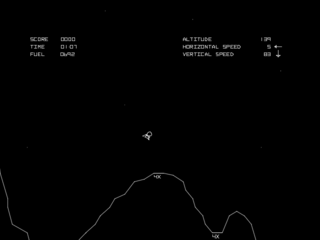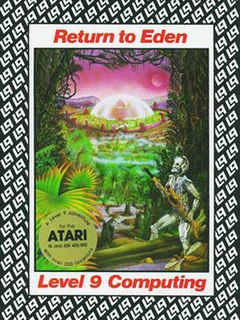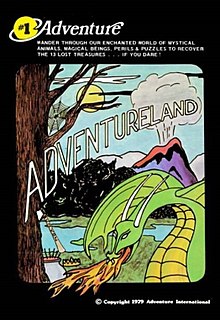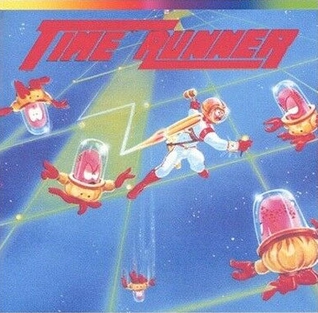Related Research Articles

The Commodore VIC-20 is an 8-bit home computer that was sold by Commodore Business Machines. The VIC-20 was announced in 1980, roughly three years after Commodore's first personal computer, the PET. The VIC-20 was the first computer of any description to sell one million units. It was described as "one of the first anti-spectatorial, non-esoteric computers by design...no longer relegated to hobbyist/enthusiasts or those with money, the computer Commodore developed was the computer of the future."

Scott Adams is an American entrepreneur, computer programmer, and video game designer. He co-founded, with ex-wife Alexis, Adventure International in 1979. The company developed and published video games for home computers. The cornerstone products of Adventure International in its early years were the Adventure series of text adventures written by Adams.

Lunar Lander is a genre of video games loosely based on the 1969 landing of the Apollo Lunar Module on the Moon. In Lunar Lander games, players generally control a spacecraft as it falls toward the surface of the Moon or other astronomical body, using thrusters to slow the ship's descent and control its horizontal motion to reach a safe landing area. Crashing into obstacles, hitting the surface at too high a velocity, or running out of fuel all result in failure. In some games in the genre, the ship's orientation must be adjusted as well as its horizontal and vertical velocities.

Questprobe is a trilogy of graphical adventure video games featuring Marvel Comics characters. The three games are Questprobe featuring The Hulk, Questprobe featuring Spider-Man and Questprobe featuring Human Torch and Thing.

Epyx, Inc. was a video game developer and publisher active in the late 1970s and 1980s. The company was founded as Automated Simulations by Jim Connelley and Jon Freeman, originally using Epyx as a brand name for action-oriented games before renaming the company to match in 1983. Epyx published a long series of games through the 1980s. The company is currently owned by Bridgestone Multimedia Group Global.

Level 9 was a British developer of computer software, active between 1981 and 1991. Founded by Mike, Nicholas and Pete Austin, the company produced software for the BBC Micro, Nascom, ZX Spectrum, Commodore 64, Oric, Atari, Lynx 48k, RML 380Z, Amstrad CPC, MSX, Amiga, Apple II, Memotech MTX, and Enterprise platforms and is best known for its successful text adventure games until a general decline in the text adventure market forced their closure in June 1991.

Temple of Apshai is a dungeon crawl role-playing video game developed and published by Automated Simulations in 1979. Originating on the TRS-80 and Commodore PET, it was followed by several updated versions for other computers between 1980 and 1986.
Fueled by the previous year's release of the colorful and appealing Pac-Man, the audience for arcade games in 1981 became much wider. Pac-Man influenced maze games began appearing in arcades and on home systems. Pac-Man was again the year's highest-grossing video game for the second year in a row. Nintendo released the arcade game Donkey Kong, which defined the platformer genre. Other arcade hits released in 1981 include Defender, Scramble, Frogger, Galaga and Zaxxon.

Sea Dragon is a horizontally scrolling shooter for the TRS-80 computer, written by Wayne Westmoreland and Terry Gilman, and released in 1982 by Adventure International. The gameplay is similar to the Scramble arcade game, but underwater. It was ported to the Apple II, Atari 8-bit family, Commodore 64, TRS-80 Color Computer, and IBM PC.

Adventureland is the first text adventure video game for microcomputers, released by Scott Adams in 1978. The game involves searching for thirteen lost artifacts in a fantasy setting. Its success led Adams to form Adventure International, which went on to publish thirteen similar games in the Adventure series, each in different settings.
Perseus and Andromeda is a text adventure video game released in 1983 by Digital Fantasia on the Mysterious Adventures label. It was available for the ZX Spectrum, Atari 8-bit, Acorn Electron, BBC Micro, Commodore 64, Dragon 32/64, and Oric-1.

SoftSide is a defunct computer magazine, begun in October 1978 by Roger Robitaille and published by SoftSide Publications of Milford, New Hampshire.
Waxworks is an interactive fiction game by Brian Howarth and Cliff J. Ogden. It was published by Digital Fantasia in 1983 for the Commodore 64, Plus/4, ZX Spectrum, and BBC Micro. It was the 11th game in the Mysterious Adventures series.

Forbidden Forest is a game designed by Paul Norman, published by Cosmi Corporation in 1983 for the Commodore 64 and Atari 8-bit family.
Adventure International was an American video game publishing company that existed from 1979 until 1986. It was started by Scott and Alexis Adams. Their games were notable for being the first implementation of the adventure genre to run on a microcomputer system. The adventure game concept originally came from Colossal Cave Adventure which ran strictly on large mainframe systems at the time.

Warrior of Ras: Volume I - Dunzhin is a fantasy role-playing video game developed by Med Systems Software. The game was released on the TRS-80 in 1982, then ported to the Apple II, Atari 8-bit family, and Commodore 64. A self-booting IBM PC port added digitized speech.
Russ Wetmore is an American computer programmer and video game designer best known for writing commercial games and applications for the Atari 8-bit family in the early to mid 1980s. His Frogger-inspired Preppie! was published by Adventure International, as well as its sequel. He stopped writing games after the video game crash of 1983 and developed the integrated HomePak productivity suite for Batteries Included.

Time Runner is a maze video game, similar to Konami's 1981 Amidar arcade game, published by Funsoft in 1981. It was written for the TRS-80 by Yves Lempereur who also wrote an Atari 8-bit family version released the same year. A port to the Commodore 64 by Scott Maxwell and Troy Lyndon was published in 1983.
References
- 1 2 "Fantasia Fiasco". Home Computing Weekly. Argus Specialist (17): 5. 1983.
- 1 2 3 "The Mysterious Adventures of Brian Howarth".
- 1 2 3 4 5 Francis, Garry (March–April 1985). "The Golden Baton". Atari Users Magazine. No. 14.
- ↑ ":: CASA :: Interview Brian".
- ↑ https://www.retrogamer.net/profiles/company/adventuresoft-uk/
- ↑ Graham, Nelson (2001). The Inform Designer's Manual (PDF). Dan Sanderson. p. 358.
- ↑ "Fantasia Converts Adventures". Popular Computing Weekly. Sunshine Publications. 2 (43): 5. 1983.
- ↑ "Your Commodore Magazine Issue 03". December 1984.
- ↑ "World of Spectrum - the Golden Baton".
- ↑ "ZZap!64 Magazine Issue 002". June 1985.
- ↑ "CRASH 21 - the Touchstones of Rhiannon".
- ↑ http://www.gamebase64.com/oldsite/gameofweek/4/gotw_supergran.htm
- ↑ http://www.ataricave.com/T/TheTimeMachine.htm
- ↑ "Atari 400 800 XL XE Mysterious Adventure No. 4 - Arrow of Death - Part 2 : Scans, dump, download, screenshots, ads, videos, catalog, instructions, roms".
- ↑ "Escape from Pulsar 7".
- ↑ "Circus".
- ↑ Graham, Nelson (2001). The Inform Designer's Manual (PDF). Dan Sanderson. p. 399.
- ↑ http://bbcmicro.co.uk/game.php?id=1763
- ↑ http://bbcmicro.co.uk/game.php?id=1777
- ↑ "Ten Little Indians".
- ↑ "Waxworks".
- ↑ "Edge magazine's 20 strangest moments in videogaming". Edge. No. 130. December 2003.